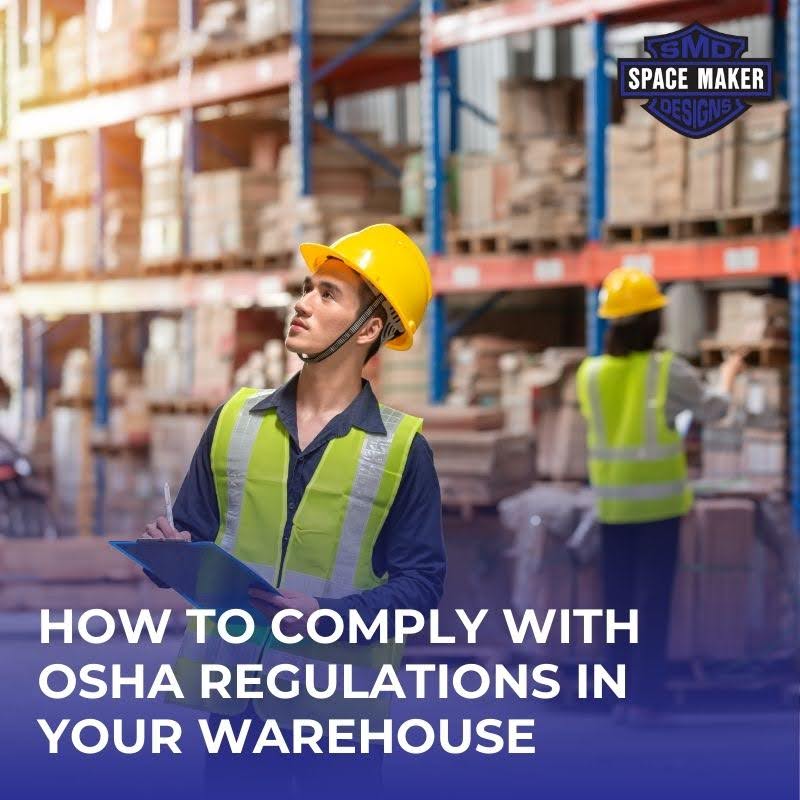Key Takeaways
- Prioritize Proactive OSHA Compliance: Understand and adhere to OSHA regulations for legal compliance and employee safety. Proactively mitigate risks by staying informed about specific standards, including fire safety, machine guarding, and electrical regulations.
- Embrace Safety Audits for Improvement: Regular safety audits evaluate warehouse activities, ensuring efficiency, compliance, and risk identification. Post-audit actions involve transparent communication, prompt corrective measures, and continuous improvement, making audits integral to a safer workplace.
- Cultivate a Comprehensive Safety Culture: Invest in mandatory employee training, continuous learning, and certifications to reinforce safety principles. Develop a safety culture through leadership commitment, employee engagement, and continuous improvement. Alongside these critical strategies, consider optimizing your warehouse space efficiently with Space Maker Designs’ top industrial shelving solutions. These tailored systems are engineered to not only maximize storage capacity but also support an organized, productive, and safe work environment.
How to Comply with OSHA Regulations in Your Warehouse
The Occupational Safety and Health Administration (OSHA) sets out guidelines that aim to minimize accidents, enhance safety, and ensure a compliant workplace. Ignoring these regulations can lead to serious consequences, including fines, legal repercussions, and, most importantly, employee injuries or fatalities. As we walk through the essentials of OSHA compliance, we will focus on practical steps to create a safer warehouse environment. To further this endeavor, Space Maker Designs offers Warehouse Operation and Rack Inspections to ensure that your facility not only follows OSHA guidelines but sets a standard for safety excellence in your industry.
Understanding OSHA Regulations For Warehouses
Ensuring your warehouse adheres to OSHA regulations is essential for legal compliance and the safety of your employees. These rules encompass a broad range of practices, from proper handling of hazardous materials to ergonomic standards for lifting. As a warehouse operator, it's your responsibility to stay informed of the specific OSHA standards that apply to your facility. This includes requirements for fire safety, machine guarding, and electrical regulations. By understanding OSHA's framework, you can take proactive steps to mitigate risks and create a safe working environment for your team.
Elevate Your Warehouse Safety With Space Maker Designs
- Stay Informed — Keep up with the latest OSHA standards and best practices for warehouse operations.
- Enhance Training — Equip your staff with the knowledge and skills they need for a safer work environment.
- Achieve Compliance — Partner with Space Maker Designs to ensure your warehouse meets and exceeds safety regulations.
Take the first step towards comprehensive compliance and a superior safety culture with Space Maker Designs.
Conducting A Warehouse Safety Audit
The Purpose Of A Safety Audit
Safety audits are systematic, critical examinations of how your warehouse's activities impact worker safety. By conducting regular audits, you can uncover potential safety risks before they lead to injuries. Audits should assess the efficiency of safety protocols, ensure compliance with regulations, and identify areas for improvement. A thorough audit will not only keep your operations in line with OSHA standards but also reinforce your commitment to protecting your workforce. This process demonstrates due diligence in maintaining a safe environment and can often lead to process optimizations that enhance productivity.
Steps To Conduct An Audit
Start your safety audit by reviewing current safety policies and comparing them against OSHA standards. Engage with employees at all levels to gather feedback on the practical application of these protocols. Examine the physical workspace, looking for hazards like improper storage or damaged equipment. Documentation reviews, such as past incident reports and training records, will reveal trends and potential areas of concern. Once your assessment is complete, compile your findings into an actionable report. Prioritize the riskiest issues for immediate attention, and develop a timeline for addressing other findings.
Post-Audit Actions
After the warehouse safety audit, establish a plan to address the identified issues. Communicate the findings to management and staff, ensuring transparency and fostering trust. Implement corrective measures promptly, and monitor their effectiveness over time. Provide additional staff training, if necessary, to ensure that everyone understands new safety measures. Follow-up audits should be scheduled to ensure ongoing compliance and to evaluate the long-term effectiveness of any changes made. Remember, an audit is not a one-time event but an integral part of a continuous improvement process.
Safety Training For Warehouse Employees
Mandatory Training Requirements
OSHA requires that warehouse employees receive training on specific topics relevant to their job functions. This includes the handling of materials, operation of equipment, and emergency procedures. Such training is not just a formal requirement—it's a critical component of any safety program. It empowers your team to work safely and can significantly reduce the incidence of workplace accidents. Employee training should be both comprehensive and understandable, tailored to the diverse needs of your workforce.
Continuous Learning & Certification
Developing a program for continuous learning helps keep safety at the forefront of your employees' minds. Besides the required initial training, consider implementing regular refresher courses to reinforce key safety principles. Certain roles may necessitate certifications, such as forklift operators, and maintaining these credentials is essential. Provide opportunities for your staff to attend external training and seminars that can bring new insights into safety best practices. Investing in your employees' education is investing in your business's resilience and reputation.
Assessing Training Effectiveness
Assessment is vital in ensuring that the safety training provided is both retained and applied by employees. Use quizzes, practical demonstrations, and regular reviews to evaluate understanding. Observing employees on the job will also give real-world insights into the practical application of their training. Remember, the goal is not only to impart knowledge but to create a workforce that instinctively prioritizes safety in their day-to-day actions. Adjust your training approach based on these assessments to fill any gaps in knowledge or application.
Warehouse Equipment Safety Standards
Equipment Maintenance And Inspection
Proper equipment maintenance is crucial for avoiding malfunctions that can lead to accidents. OSHA requires routine inspections and maintenance of all warehouse equipment. Develop a schedule that aligns with manufacturer recommendations and regulatory requirements. Records should be kept of all maintenance activities, including inspections, repairs, and parts replacements. Well-maintained equipment operates more efficiently, lasts longer, and most importantly, keeps your employees safer.
Safe Operation Guidelines
Establish clear guidelines for the safe operation of all warehouse equipment. Operators must be trained to understand the limits and capabilities of the machinery they use. Stress the importance of using equipment only for its intended purpose. Any modifications to equipment should follow manufacturer guidelines and OSHA regulations. Implement a system of checks and balances where equipment is regularly monitored by both operators and supervisors to ensure adherence to safety protocols.
Responding To Equipment Failures
Even with diligent maintenance, equipment can fail. Prepare your team to respond correctly to such situations. They should know how to safely shut down malfunctioning equipment and whom to notify about the issue. A clear procedure for tagging and reporting defective machinery will prevent others from using it until it's repaired. Implement contingency plans for such events to minimize operational disruptions while maintaining safety. Training and preparation will ensure that equipment failures are managed effectively and safely.
Hazard Identification And Control
Recognizing Potential Hazards
The first step in hazard management is to identify potential risks in your warehouse. Risks can come from various sources, such as equipment operation, materials handling, and even the warehouse layout. Involve employees in the identification process, as they are often best positioned to notice hazards in their daily work. Create a reporting system that encourages them to communicate any risks they encounter. Regularly review these reports to identify patterns and address systemic issues.
Implementing Control Measures
After identifying hazards, take steps to either remove the risk or control it to prevent harm. Implementing control measures might include rearranging the workplace to improve ergonomics, updating equipment, or introducing new work procedures. Encourage a proactive approach where potential risks are managed before they become actual problems. Test these controls to ensure their efficacy and educate your staff on any new measures put in place. The goal is always to preempt hazards rather than react to them.
Regular Review And Adaptation
A static safety system is often a failing one. The warehouse environment is dynamic, with changing processes, equipment, and personnel. Regularly reviewing your hazard controls ensures that they remain effective and relevant. Be prepared to adapt your safety strategies as your operation grows or as new regulations come into effect. Encouraging a continuous feedback loop from employees can provide valuable insights into what's working and what might need adjustment.
Emergency Preparedness And Response
Emergency Action Plan (EAP)
Develop a comprehensive Emergency Action Plan (EAP) that is specific to the risks and layout of your warehouse. The EAP should include evacuation routes, assembly points, and strategies for different scenarios like fires or chemical spills. Make sure that all employees are familiar with the plan and participate in regular drills. Clear signage should indicate emergency exits, and first-aid kits and fire extinguishers should be accessible throughout the warehouse.
Evacuation Procedures And Drills
Evacuation procedures form a central part of any emergency response. These should be clear, straightforward, and practiced regularly. Drills will help identify any gaps in the plan and give employees the confidence to act decisively in an actual emergency. Assign roles and responsibilities to designated staff members to ensure an organized evacuation process. Regular reviews of procedures and feedback from drills will help keep your EAP current and effective.
Handling Specific Emergencies
Different emergencies may require unique responses. Make sure your EAP addresses specific scenarios relevant to your warehouse, such as hazardous material spills, electrical fires, or severe weather. Train employees on how to handle these situations safely and who to contact for assistance. Equipment such as spill containment kits, fire blankets, or storm shelters should be readily available and maintained. Your emergency response should be as tailored and specific as the risks faced by your warehouse.
Handling OSHA Inspections
Preparing For An OSHA Inspection
Prepare your warehouse for OSHA inspections by ensuring that you are consistently adhering to all relevant regulations. Keep all required documentation organized and easily accessible, including permits, training records, and safety audit reports. Regular self-audits can identify any areas of non-compliance before an inspector does. Employee training should include what to expect during an inspection and the importance of honesty and cooperation.
Responding To Violations And Penalties
If an OSHA inspection results in the identification of violations, respond promptly and decisively. Take note of the specific issues highlighted by the inspector and create a plan for rectifying these violations within the given timeframes. Take this as an opportunity for improvement rather than a setback. Penalties should serve as a reminder of the importance of compliance and the costs of failing to prioritize safety.
Post-Inspection Follow-Up
A critical part of the inspection process is following up on any findings. Submit required documentation to OSHA on time, and provide evidence of the corrective actions taken for any violations. Keep the lines of communication open with the inspector, and seek clarification if there's any uncertainty about requirements. Implementing the changes after an inspection not only prevents further penalties but also enhances your overall safety program.
Creating A Culture Of Safety
Leadership And Employee Engagement
Creating a culture of safety starts at the top. Management must lead by example, underscoring the importance of safety in every aspect of operations. Engage employees through regular communication, involving them in safety planning and decisions. Recognize and reward safe behaviors to reinforce the value your organization places on the well-being of its staff. A safety culture is built on trust and shared commitment between employers and employees, with everyone working towards the common goal of a safe workplace.
Continuous Improvement
Safety is not a static target but an ongoing pursuit. Encourage an environment where continuous improvement is the norm. Regularly review and update safety procedures to reflect changes in operations, equipment, or regulations. Invest in new technologies or processes that can enhance safety. Always be open to feedback from employees—they are the ones who often have the most direct understanding of what is and isn't working on the warehouse floor.
Measuring Safety Performance
Measuring safety performance is essential to maintaining and improving your safety culture. Key performance indicators (KPIs) could include the number of accidents or near-misses, days lost due to injury, or safety audit scores. Use these metrics to monitor progress, and don't hesitate to set ambitious goals for improvement. Regularly sharing these results with employees reaffirms the importance placed on safety and keeps the entire team aligned on objectives.
Final Thoughts On OSHA Regulations For Warehouses
Compliance with OSHA regulations is not just a legal mandate but a moral imperative. It demonstrates a commitment to the well-being of those who work within your warehouse. By understanding and applying OSHA guidelines diligently, conducting comprehensive safety audits, and fostering a culture that values safety above all, you can ensure a safer, more productive workplace. Regular Warehouse Operation and Rack Inspections by Space Maker Designs provide a systematic approach to ensure that your storage systems meet OSHA guidelines and support safety in every aspect of your operations.
Read Also:
Read Also:
- THE BENEFITS OF INDUSTRIAL STORAGE RACKS FOR YOUR WAREHOUSE
- A COMPREHENSIVE OVERVIEW OF DIFFERENT TYPES OF WAREHOUSE RACK
- HOW TO CHOOSE THE RIGHT FORKLIFT FOR YOUR DALLAS WAREHOUSE
Frequently Asked Questions About OSHA Regulations For Warehouses
What should be included in a warehouse safety audit?
A safety audit should include a review of policies against OSHA standards, employee feedback, a physical inspection of the workspace, an analysis of past incident reports, and an action plan for rectification.
What specifics should warehouse safety training cover?
Training should encompass material handling, safe machinery operation, emergency procedures, and prevention and response to workplace accidents.
How should equipment maintenance records be managed?
Equipment maintenance records should be timely updated, clearly documented, and kept for the period specified by OSHA, reflecting all inspections, repairs, and replacements.
What tactics are effective for hazard control in a warehouse?
Effective tactics include routine assessment of potential risks, employee engagement in hazard identification, and implementation and regular review of control measures.
How do you develop an effective Emergency Action Plan?
An effective EAP includes clearly outlined evacuation routes, specific procedures for various emergencies, designated roles, and regular drills and training.
What incidents must be immediately reported to OSHA?
Workplace fatalities, severe injuries such as amputations or loss of an eye, and hospitalizations must be reported to OSHA within specific timeframes.
How can an organization prepare for unexpected OSHA inspections?
Organizations can prepare by maintaining regular self-audits, ensuring documentation is organized and accessible, and training staff on what to expect during an inspection.
How to foster employee engagement in warehouse safety?
Employers can engage employees by involving them in safety discussions, soliciting feedback on protocols, and actively participating in safety training and drills.
What are the consequences of failing to comply with OSHA regulations?
Consequences can include fines, legal actions, an increase in workplace accidents, and potential damage to the company's reputation and productivity.
How does safety compliance benefit a warehouse operation?
Safety compliance lowers the risk of workplace accidents, reduces legal liabilities, improves productivity, and enhances overall workforce morale and trust.



